

Jan 2021 update - 'KW Electronics' has re-started with its 2nd new owner in recent years. The name is now owned by Nigel M0CVO who markets antennas and accessories. Nigel has added a KW Electronics page to his website with a few small kits, and I understand the product list will grow in the future.
Although my Drake collection had grown in the early 2000s I realised that I had neglected KW after I sold my KW2000A in 1979 - time to start collecting !. The Company had a special place in my teenage Ham years as my very good friend Paul G4BXT (now sadly SK) lived 100yds from the Works. On some Saturdays in 1971/2 the two teenage hams would go into the showroom to look at the shiny new KW2000B's, KW Atlantas and the separates. The guys were very good to us youngsters and let us play with the demo gear. I Currently live 1 mile away from the old Vanguard Works - THERE CANT BE MANY HAMS ACROSS THE WORLD WHO USE GEAR THAT WAS MADE 1 MILE FROM THEIR HOUSE !
BRIEF HISTORY
KW started life in January 1956, when Roland (Rowley) Shears - G8KW and Ken
Ellis - G5KW, began
importing Geloso VFO's from Italy and making antennas, dummy loads and
accessories for the UK ham market in Rowley's house. The rare ID
Plate shows Rowley's house address, its on a TVI filter to notch out UK
VHF TV CH1 on 45MHz. Part of my collection and it dates from the late
50's. We drive past this house every week and doff our caps to the late
Mr Shears. In June 2020 a kindly chap sent my some KW publicity material
that was sent out in 1957. It mentions VHF equipment for both ham and
commercial users - I am not sure who made this equipment, my best guess
would be Burndept (a local Company in Erith). Despite adverts around
this time KW gave up on any VHF equipment when its HF gear started
selling in larger numbers
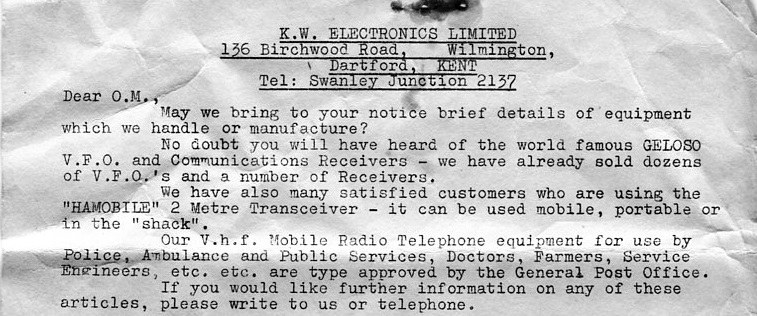
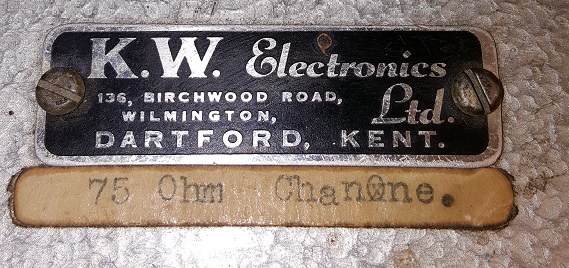 .
.
AM transmitters and receivers quickly followed with the KW Valiant, KW Vanguard - and cute little KW160. SSB equipment appeared in the late 50s but in the 'boat anchor' style - the early Mk1 KW Viceroy SSB transmitter had a huge separate PSU. The Viceroy TX went through 4 or 5 updates over its life and was made well into the 60s, ending with the MK IV - although it was still a beast..I know because I have a superb example paired up with a KW77 receiver.
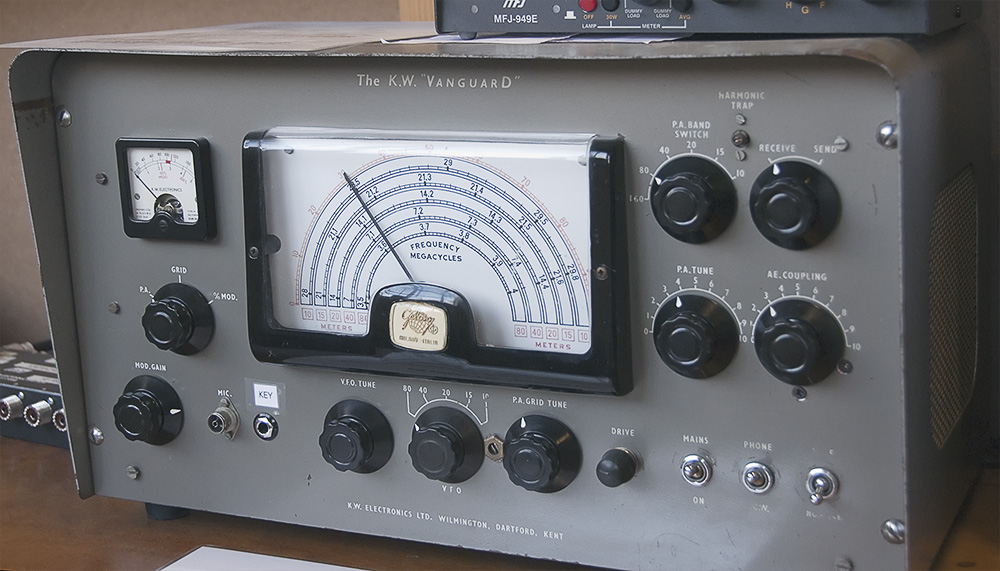

KW even managed to get one of their AM Transmitters into a James Bond film - Dr No - all British line up, KW and Eddystone !..Looks like around 14.25MHz...poor choice of frequency guys !

This photo must have been taken in 1962/63 as these are early version KW-77 receivers
The KW2000 and the 'G LINE'
Early in the 60's Rowley and his small team must have realised that smaller (and lighter) SSB equipment was going to be the future of the hobby on HF. A quick glance at early 60's UK ham radio magazines shows that a large number of operators were still using AM. Many were using war surplus kit and a receiver without a proper product detector is poor on SSB.
In the US the Collins Radio Company had started the trend with their innovative SSB transceiver - the KWM-1, shortly followed by the legendary KWM -2 - a masterpiece of radio design (but expensive). The KW team took the basic concept of the Collins equipment and re-designed it so it could be manufactured in the UK and sold far cheaper than any imported US equipment - the team called it 'Project 2000' . This rare picture of the prototype looks really nice, although the radio became a bit cluttered with the addition of VOX and IRT in production. The original press cuttings at the time of release say that the radio was specifically designed with mobile operation in mind. They also indicate the radio was fitted with VOX, but the odd 'VOX BOX' in the MK1 2000s is not in any of the photos of the prototype.
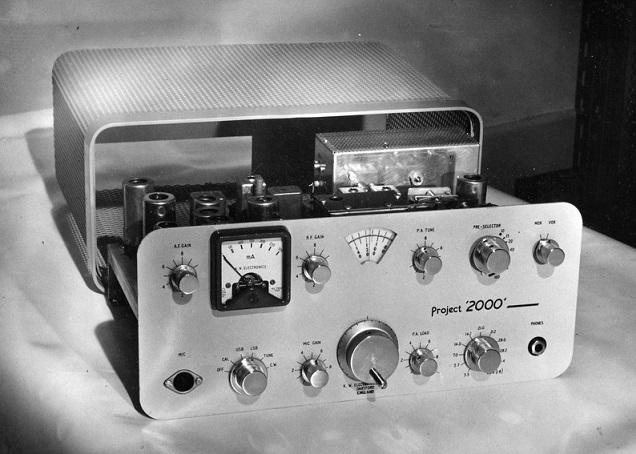
Corners had to be cut however - the Collins permeability tuned VFO (PTO) was replaced with a conventional design - The front end and driver tuned circuits on the higher bands were wound directly around the ferrite slugs (and glued in place) and placed in a series / parallel arrangement with the 160/80m coil (makes alignment a bit more tricky!). The premix crystal oscillator coils are also wound the same way and this again makes alignment very tedious - you have to have a bottle of nail varnish remover to hand !. Note also that the RX RF amplifier screen resistors are gradually switched out as you go up the bands. This is probably to try and overcome the losses introduced by the poor front end design on the higher bands and was not improved until the 2000E came out. The Heathkit SB and HW line use the series parallel coil approach as well, and leave the RX RF amplifier at high gain. It may be unkind, but compared to the superbly engineered and documented Collins KWM 2/2A the KW2000 was clearly more of an 'amateur radio' product.
The basic radio architecture is the same - Dual conversion, broadband 2.955 to 3.155MHz first IF, 455kHz final IF, Kokusai Mechanical filter (instead of Collins), 200kHz band segments, 6146 output tubes, KW also added 160m, IRT, VOX and the turned aluminium knobs were a nice touch.
Thus the very British KW2000 series of HF radio transceivers were born. The earliest model (I call it the MK1) released in late 1963 had one 6146 in the PA and was very compact, it had a tendency to drift if used mobile as the vehicle battery voltage and the VFO heater supply changed - pull away from the lights and move up the band a bit!. Despite these niggles it was far cheaper then the competition and sold well, although clearly some improvements were needed. They first came in the form of the KW2000A model introduced at the end of 1964 for shipping in 1965. Two 6146 PA tubes were fitted into a deeper chassis and the VFO and premix valve heaters were run from a separate 6V supply to cut down the drift with supply voltage changes. With the launch of the KW2000A, the cases were redesigned to match across the expanding SSB range and KW called it the 'G line' - a clear copy of Collins 'S Line' philosphy.
Despite the introduction of the KW2000A in late 1964 the original 90W 2000 MK1 stayed in production alongside it for a further 2 years. In the December 1964 Short Wave Magazine KW explained that the early 2000 had become very popular and would stay in the product line. Although either rig could be used with a mobile DC supply, the smaller size and lower power consumption of the MK1 must have made it popular with mobile operators.
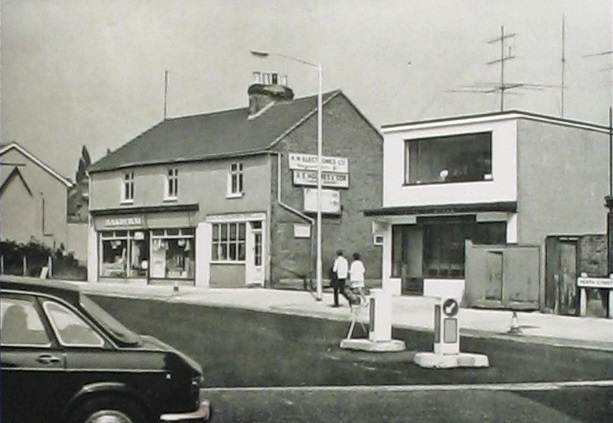
Entrance to the KW 'Vanguard Works' in Dartford visited frequently by a young G3ZPS and his mate G4BXT (who lived just behind the building). The property was rented and the buildings are still there. For a time KW had another small 'works' in Crayford about 2 miles away
It also looks like KW struck some sort of a deal to license the KW2000(A?) to Hammerlund in the USA, There is one advert in circulation of the HXQ-300 that looks exactly like the 2000. How they claim 300W input is beyond me unless Hammerlund changed the OP valves to sweep tubes. I am not sure they ever put this rig into production as it appears to have sunk without a trace

 By 1969 the storm clouds were gathering for UK and US Ham Radio
manufacturers, but KW managed to upgrade the 2000A to the 2000B and
found a real winner in the UK market. As well as a few minor design
tweaks the big improvement was a 2
speed dial mechanism with a slightly better readout and the rig sold like hot cakes
for a few years. There are stories of queues of UK hams turning up at the
Dartford Works (pic above) on a Saturday to pay cash for their new KW2000B !.
Although there was some preliminary work on a transistor version
(KW2000T?) and some prototypes of the digital readout 2000D, the
last model was the almost all valve 2000E from 1973 until around 1976 (its missing from the 1976/7 KW
catalogue). Although it was the first (and only) extensive redesign of the KW2000, had an improved receiver front end and
500kHz band segments, it suffered from further cost cutting, strong
competition and limited
development . There was no denying that by the time of is
introduction all valve HF SSB
transceivers were a dying breed (it turned out to be a slow and
painful death for Drake, KW and Swan amongst others). The
commercial variant - the KW2000C/CA/CAT - channelised radio telephone sold
well into the 70's and in its last incarnation used solid state Plessey devices
for the low level signal generation. The KW2000 was a very innovative UK
product on its launch but technology was moving very rapidly in the 60s
and early 70s and ultimately KW just did not have the resources to keep up with the
pace of change.
By 1969 the storm clouds were gathering for UK and US Ham Radio
manufacturers, but KW managed to upgrade the 2000A to the 2000B and
found a real winner in the UK market. As well as a few minor design
tweaks the big improvement was a 2
speed dial mechanism with a slightly better readout and the rig sold like hot cakes
for a few years. There are stories of queues of UK hams turning up at the
Dartford Works (pic above) on a Saturday to pay cash for their new KW2000B !.
Although there was some preliminary work on a transistor version
(KW2000T?) and some prototypes of the digital readout 2000D, the
last model was the almost all valve 2000E from 1973 until around 1976 (its missing from the 1976/7 KW
catalogue). Although it was the first (and only) extensive redesign of the KW2000, had an improved receiver front end and
500kHz band segments, it suffered from further cost cutting, strong
competition and limited
development . There was no denying that by the time of is
introduction all valve HF SSB
transceivers were a dying breed (it turned out to be a slow and
painful death for Drake, KW and Swan amongst others). The
commercial variant - the KW2000C/CA/CAT - channelised radio telephone sold
well into the 70's and in its last incarnation used solid state Plessey devices
for the low level signal generation. The KW2000 was a very innovative UK
product on its launch but technology was moving very rapidly in the 60s
and early 70s and ultimately KW just did not have the resources to keep up with the
pace of change.
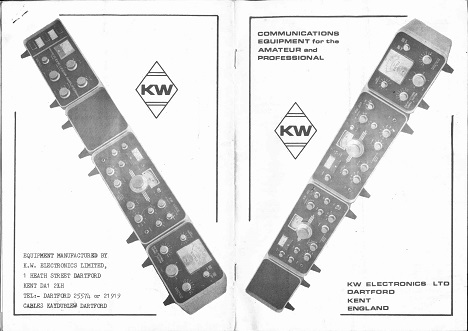 KW tried to break into the US ham market
in 1969 with its SWAN 500 copy - the KW Atlanta. The
Company was sold to Decca in 1974 (Decca were more interested in the
profitable commercial arm of KW than developing the ham radio line), but
by then sales of Yaesu, Icom and Kenwood had grown rapidly in the UK,
and - shock horror! - they used extensive solid state circuitry. The
Yaesu FT101 was the epitome of Japanese design and innovation - it was
the next generation. The last catalogue of KW ham equipment is from
1977. Decca were bought by the Racal Group in 1980 for $250m - Racal
were keen on Decca's expertise in microwave radio and electronic warfare
systems, but most definately not in ham radio!. Rowley managed to buy the rights to the KW name
back along with quite a lot of assets and carried on trading as a ham
radio supplier selling KW ancillaries and TEN TEC rigs until he retired in 1989.
KW tried to break into the US ham market
in 1969 with its SWAN 500 copy - the KW Atlanta. The
Company was sold to Decca in 1974 (Decca were more interested in the
profitable commercial arm of KW than developing the ham radio line), but
by then sales of Yaesu, Icom and Kenwood had grown rapidly in the UK,
and - shock horror! - they used extensive solid state circuitry. The
Yaesu FT101 was the epitome of Japanese design and innovation - it was
the next generation. The last catalogue of KW ham equipment is from
1977. Decca were bought by the Racal Group in 1980 for $250m - Racal
were keen on Decca's expertise in microwave radio and electronic warfare
systems, but most definately not in ham radio!. Rowley managed to buy the rights to the KW name
back along with quite a lot of assets and carried on trading as a ham
radio supplier selling KW ancillaries and TEN TEC rigs until he retired in 1989.
Peter Chadwick G3RZP worked for KW for a few years and wrote an excellent article in 2010 on the KW2000 series, I have linked it here. The inspirational founder of KW - Rowley Shears died in 2009 - and only after his death did his amazing wartime radio exploits come to light - but that is another story!. There is also an avid group of KW collectors and restorers on the KW User Group. Every January a group of KW enthusiasts get together on the HF bands and celebrate the founding of the Company in 1956..look out for us as GB8KW, GB2KW and even G8KW (now issued to to Rowley's son Richard). At the 2018 event I was thrilled to operate as G8KW on 80m from Cray Valley Radio Society on our KW activity weekend. Richard Shears attended the event and it was great to switch from GB8KW to G8KW. The Jan 2021 event was limited by the covid pandemic but a number of special KW stations (including GB8KW from Guy G0UKN) were on to celebrate thr 65th anniversary of the company (some will be on for the whole of January)
Autumn 2020 update
Late in 2020 another twist in the history of KW came to light. Robert EA4BZT contacted the KW user group to tell us the story of how his late father managed to buy a number of unbuilt KW2000E transceivers and have them assembled in Spain. It was a bit of a surprise to find out that the very last KW transceivers were built there..he told us the following story ;
My late father, Bob Benyon G3FXG / EA5CNG was a good friend of Rowley Shears, G8KW. When we moved to Spain in 1970, foreign nationals couldn't have an amateur radio license, so my mother sat the exam and obtained her full license in the early 1970s with callsign EA5MP and my father was authorized to be second operator.
They set up MP ELECTRONICS, in Castellón de la Plana, on the mediterranean coast about 70 km north of Valencia, and purchased the remaining parts of the KW2000E from Decca communications Ltd and those of the KW 107 Supermatch. They didn't have the cases, so they were made locally and the panels of the 107s were silk screen printed in a ceramic tile factory. In all, about 100 KW2000E and 50 KW107 were built by my father.
I was only allowed to make the cable harnesses and rivet the valve holders to the aluminium chasis. He gave me the last one when I went to boarding school in the UK. I got my callsign G4KSK and thanks to Rowley, who taught me morse and corrected me whilst reading the paper! Rowley was my assigned guardian whilst at school and I spent the half-terms with them in Sevenoaks. The last 2000E built was used in the Caterham School radio club from 1977-1981. It is still working fine. I switch it on once a month just to keep it alive...
Just wanted to add this litte bit to the history, and to put on record that the last KW was not built in the UK, but was assembled by an expat in Castellón.
In yet a further twist to the story one of the very last ones made may have been a pre-production KW2000D that was converted back to a E variant in Spain. There were certainly rumours of a missing KW2000D and this may well be it !
KEEPING THEM GOING
I have had no real problems in getting any KW gear back on the air - the simplicity of the designs means most faults are easy to find. This valve gear is best looked after by those who really know what they are doing, you need to get inside and be aware of the danger of high voltages. I have seen some really daft questions on the forums like - ' my Drake TR4 has stopped transmitting..any ideas?' .
The single biggest issue I have faced are the dreadful mods and bodges carried out by previous owners. Nearly every radio has been got at, and some with the most appalling (and downright dangerous) changes. It seems that many 1960 and 70's radio hams had very limited engineering skills - which is at odds with a scientific hobby like ours. I am amazed that some of the radios survived at all.
All the valves used in KW kit are available, passive components are easy to replace and even the mechanical IF filters can be replaced with more modern Murata CFJ455K variants (although these are also getting harder to get). Resistors go high and are easy to check, Hunts caps are awful (but not used in every KW), the resistor trimpots used in the 2000 RIT and S meter circuitry get dirty and cause problems (erratic S meter, different TX and RX frequencies) and I change them. Relays can be problematic, clean the plug in pins with metal polish and the contacts with non abrasive cleaner. Disc ceramic caps are pretty reliable. I have built up a stock of parts that should last me out. I only restore radios that are mostly complete, total wrecks are not for me !.
MECHANICAL 455kHz FILTER
One of the most common problems for KW gear will be the old Kokusai mechanical filter - a lot has been written about the degradation of the foam inside the can...it turns to a sticky goo. What amazes me is that some keep on working pretty well whilst others fail or go very lossy. If the filter gets shaken up the mechanical element (no longer protected by the foam) will get damaged. Failure of the piezo trasnducers or the associated wiring may show up as a total failure or increase the loss. I have had some limited success with cleaning the filters but not 100%. If a KW radio has poor IF gain and low TX drive the filter is an obbious culprit...a proper check is to put the radio into TX in tune mode and insert some carrier to get a few watts out. Put a scope on the filter input (455KHz) and then transfer to the OP pin, the voltage difference should be less than 12dB..if its a lot more the filter is on its way out. I have directly replaced the mecahanical element with Murata CFJ455K ceramic filters and whilst the sideband suppression and shape factor is not quite as good the radio is trasnformed !. Kokusai only ever made 2 bandwidths in the can type used in KW gear - 10K suffix (about 2.1KHz SSB) and 15K suffix for wider SSB (but too narrow for decent AM reception).
The biggest enemies of any restoration project (radios, cars, houses!) are ;
1 ) Commitment, 2) Time and 3 ) Workshop facilities and spares to finish the job.
Despite the good words of many hams with restoration projects sitting under the bench, I know very few will get those old radios back on the air. Its very easy to buy them on eBay or from SK sales and then just leave them sitting for years in your workshop, thats not for me - all the radios on these webpages are restored to the best of my abilty and ARE working.
I test KW Power Supplies seperately by shorting the pins on the 15 way plug that connect to the mains switch in the radio - for safety I seal the plug inside a plastic bag. Providing the transformer is OK the PSU should come up to spec after capacitor, diode and resistor replecement. I ALWAYS CHECK the radio for any shorts on the 275V and 750V lines before re-connecting the supply, even a valve in the wrong socket can fry components.
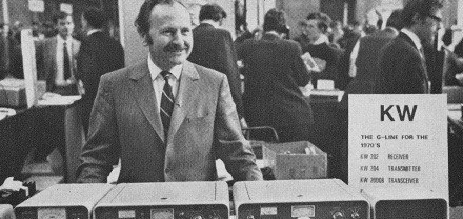
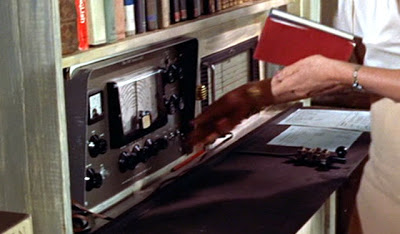
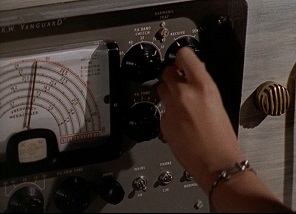
Connect with me today
Call me on 44 (0)7970 190437